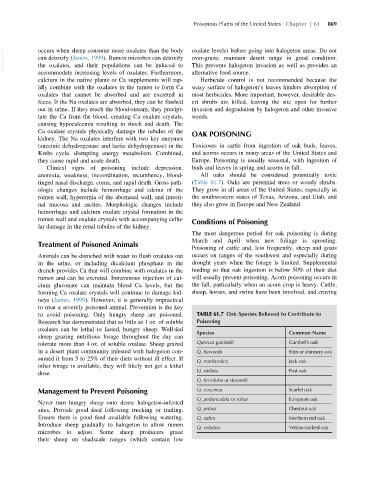Page 914 - Veterinary Toxicology, Basic and Clinical Principles, 3rd Edition
P. 914
Poisonous Plants of the United States Chapter | 61 869
VetBooks.ir occurs when sheep consume more oxalates than the body oxalate levels) before going into halogeton areas. Do not
over-graze; maintain desert range in good condition.
can detoxify (James, 1999). Rumen microbes can detoxify
This prevents halogeton invasion as well as provides an
the oxalates, and their populations can be induced to
accommodate increasing levels of oxalates. Furthermore, alternative food source.
calcium in the native plants or Ca supplements will rap- Herbicide control is not recommended because the
idly combine with the oxalates in the rumen to form Ca waxy surface of halogeton’s leaves hinders absorption of
oxalates that cannot be absorbed and are excreted in most herbicides. More important, however, desirable des-
feces. If the Na oxalates are absorbed, they can be flushed ert shrubs are killed, leaving the site open for further
out in urine. If they reach the blood-stream, they precipi- invasion and degradation by halogeton and other invasive
tate the Ca from the blood, creating Ca oxalate crystals, weeds.
causing hypocalcemia resulting in shock and death. The
Ca oxalate crystals physically damage the tubules of the OAK POISONING
kidney. The Na oxalates interfere with two key enzymes
(succinic dehydrogenase and lactic dehydrogenase) in the Toxicoses in cattle from ingestion of oak buds, leaves,
Krebs cycle, disrupting energy metabolism. Combined, and acorns occurs in many areas of the United States and
they cause rapid and acute death. Europe. Poisoning is usually seasonal, with ingestion of
Clinical signs of poisoning include depression, buds and leaves in spring and acorns in fall.
anorexia, weakness, incoordination, recumbency, blood- All oaks should be considered potentially toxic
tinged nasal discharge, coma, and rapid death. Gross path- (Table 61.7). Oaks are perennial trees or woody shrubs.
ologic changes include hemorrhage and edema of the They grow in all areas of the United States, especially in
rumen wall, hyperemia of the abomasal wall, and intesti- the southwestern states of Texas, Arizona, and Utah, and
nal mucosa and ascites. Morphologic changes include they also grow in Europe and New Zealand.
hemorrhage and calcium oxalate crystal formation in the
rumen wall and oxalate crystals with accompanying cellu- Conditions of Poisoning
lar damage in the renal tubules of the kidney.
The most dangerous period for oak poisoning is during
March and April when new foliage is sprouting.
Treatment of Poisoned Animals
Poisoning of cattle and, less frequently, sheep and goats
Animals can be drenched with water to flush oxalates out occurs on ranges of the southwest and especially during
in the urine, or including dicalcium phosphate in the drought years when the forage is limited. Supplemental
drench provides Ca that will combine with oxalates in the feeding so that oak ingestion is below 50% of their diet
rumen and can be excreted. Intravenous injection of cal- will usually prevent poisoning. Acorn poisoning occurs in
cium gluconate can maintain blood Ca levels, but the the fall, particularly when an acorn crop is heavy. Cattle,
forming Ca oxalate crystals will continue to damage kid- sheep, horses, and swine have been involved, and craving
neys (James, 1999). However, it is generally impractical
to treat a severely poisoned animal. Prevention is the key
to avoid poisoning. Only hungry sheep are poisoned. TABLE 61.7 Oak Species Believed to Contribute to
Research has demonstrated that as little as 1 oz. of soluble Poisoning
oxalates can be lethal to fasted, hungry sheep. Well-fed
Species Common Name
sheep grazing nutritious forage throughout the day can
tolerate more than 4 oz. of soluble oxalate. Sheep grazed Quercus gambelii Gambel’s oak
in a desert plant community infested with halogeton con- Q. harvardii Shin or shinnery oak
sumed it from 5 to 25% of their diets without ill effect. If
Q. marilandica Jack oak
other forage is available, they will likely not get a lethal
Q. stellata Post oak
dose.
Q. breviloba or durandii
Management to Prevent Poisoning Q. coccinea Scarlet oak
Q. pedunculata or robur European oak
Never turn hungry sheep onto dense halogeton-infested
sites. Provide good feed following trucking or trailing. Q. prinus Chestnut oak
Ensure there is good feed available following watering. Q. xubra Northern red oak
Introduce sheep gradually to halogeton to allow rumen
Q. velutina Yellow-barked oak
microbes to adjust. Some sheep producers graze
their sheep on shadscale ranges (which contain low

